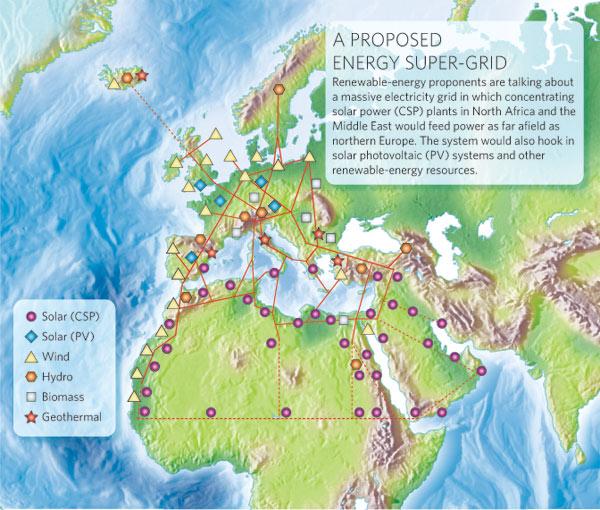The power needs of Europe, the
Middle Eastand North Africa could be met by an ambitious idea to network
renewable energies across the region. The cornerstone of the plan, developed
by a group of scientists, economists and businessmen,involves peppering
the Sahara Desert with solar thermal power plants, then transmitting the
electricity through massive grids.
Prince Hassan bin Talal of Jordan was scheduled
to present this green-energy idea, dubbed DESERTEC, to members of the European
Parliament in Brussels on 28 November.
The vision is ambitious: it would require
roughly 1,000 100-megawatt power plants, using mirrors to concentrate energy
from the Sun's rays, throughout the Middle East and North Africa to meet
the region's projected energy needs. A high-efficiency electricity grid,
yet to be built, would then ferry the power around and across the Mediterranean
Sea and northern Europe.
"The technology for the DESERTEC concept
is available and can offer unlimited, cheap and carbon-dioxide-free energy
to Europe," says Gerhard Knies, a retired physicist based in Hamburg,
Germany. Knies is co-founder of the Trans-Mediterranean Renewable Energy
Cooperation (TREC), which came up with the DESERTEC idea.
The European Union has a binding target to
get 20% of its energy from renewable sources by 2020, so the idea is gaining
support in some areas. "It makes a lot of sense to profit from the high
amount of solar radiation in the deserts," says Robert Pitz-Paal, head
of the solar research department at the German aerospace agency DLR. But
with a price tag of almost €400 billion (US$595 billion), it remains
to be seen if DESERTEC will be adopted politically.
"Unless it's extremely cheap, it won't
stop people using easy-to-get fossil fuels," says Jon Gibbins, an energy
engineer at Imperial College London. "We didn't stop using coal in the
last century because of oil."
Nationalistic concerns may also be a stumbling
block, with European politicians reluctant to be dependent on Africa. For
instance, Hermann Scheer, a member of the German parliament, is in favour
of renewable-energy approaches, but is pushing for European energy autonomy
through small, decentralized power plants on European soil.
The vision of covering the Sahara with solar
panels to generate electricity for Europe goes back to Frank Shuman, a
Philadelphia-based inventor who built a prototype solar thermal plant in
Egypt in 1913. But the idea never took off, and today solar power in the
region comes from relatively small solar-cell installations on houses and
other individual buildings. |
In 2003, Knies co-founded TREC and began presenting
the idea at conferences. He eventually got the attention of the German
environment ministry, which has commissioned three technical studies to
evaluate the concept. Germany aims to get 50% of its energy from renewable
sources by 2050, and is a leader in developing solar thermal power. "The
ministry was interested in knowing if it's feasible to import solar energy
from North Africa and to penetrate the market there," says Ralf Christmann,
an officer at the ministry.
The DESERTEC scenario foresees a mix of renewable
energies, from wind to geothermal to biomass power (see map). But the core
is solar thermal power, which uses solar energy stored in a special heat-retaining
fluid to drive a turbine and create power. First demonstrated in 1982 with
a 10-megawatt plant in California's Mojave Desert, solar thermal plants
can now produce electricity at a cost of about 15-20 eurocents per kilowatt-hour.
According to the DLR, further improvements in technology and scale could
bring that down to less than 10 eurocents per kilowatt-hour, making it
more competitive with coal.
Initial solar thermal plants are being planned
in Algeria, Egypt and Morocco, with more under construction in Spain and
Italy.
Bringing electricity from Africa to Europe
presents another challenge. The DLR says that €45 billion of the overall
budget should be invested by 2050 to place high-voltage d.c. transmission
cables throughout the region. Such a line already exists between Norway
and the Netherlands.
The DESERTEC group is asking parliamentarians
to set up a €10-billion fund to finance the development of solar thermal
plants over the next 7 years, and to establish a political framework for
the idea. But although the project may not take off on the scale its supporters
hope for soon, solar thermal power could still pick up elsewhere. "Right
now, 1,000 megawatts of solar thermal energy are being built in California
and Nevada deserts, and we are planning an additional 5,000 megawatts,"
says Dan Kammen, director of the Renewable and Appropriate Energy Laboratory
at the University of California, Berkeley. "Exploiting solar energy
from deserts is a good idea worldwide."
http://www.nature.com/news/2007/071127/full/450595a/box/1.html

|
